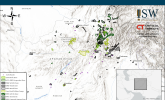November 28, 2022 - ISW Press
Recent claims of Russian gains around Bakhmut on November 27 and 28 do not portend an imminent Russian encirclement of Bakhmut. Geolocated imagery shows that Russian forces likely captured Ozarianivka (a village about 15km southwest of Bakhmut) around November 27 and 28. Multiple Russian sources claimed that Russian forces also captured Kurdiumivka (13km southwest of Bakhmut), Klishchiivka (7km southwest of Bakhmut), Andriivka (10km southwest of Bakhmut), Zelenopillia (13km south of Bakhmut), Pidhorodne (5km northeast of Bakhmut) and Spirne (30km northeast of Bakhmut) with the intention of encircling Bakhmut from the south and east. There is no open-source evidence supporting these claims at this time. Russian sources have notably propagated spurious claims regarding gains around Bakhmut as part of a continued information operation since October, and recent unsubstantiated territorial claims may be part of this continued information operation. However, even if Russian forces have indeed succeeded in taking control of settlements south of Bakhmut, these gains do not threaten the critical T0513 (Bakhmut-Siversk) and T0504 (Bakhmut-Kostyantynivka) routes that serve as major Ukrainian ground lines of communication (GLOCs) into Bakhmut. There is also a network of smaller village roads that connect to Bakhmut via the city’s northwest. The claimed Russian positions closest to Bakhmut in Klishchiivka and Pidhorodne lead directly into prepared Ukrainian defenses in Bakhmut and its western and northern satellite villages. Russian forces in Klishchiivka, in order to advance any further, would have to cross three kilometers of fields with little cover and concealment. Russian troops, in their current degraded state, are likely unable to be able to accomplish this task quickly. Wagner Group financier Yevgeniy Prigozhin himself observed in October that Wagner forces operating in the Bakhmut area advance only 100–200 meters a day. Russian claimed advances around Bakhmut over the course of November 27 and 28 are thus unlikely to generate operational-level effects and certainly not quickly.








